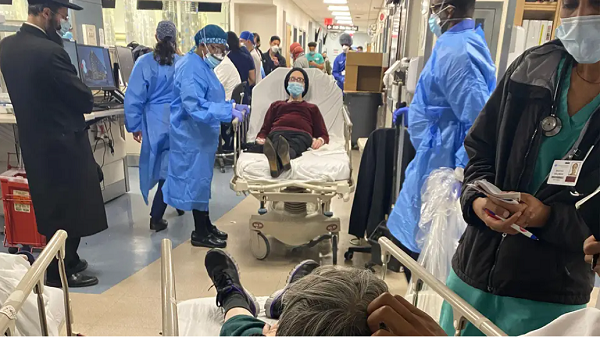Patients Are Dying in Emergency Department Waiting Rooms
By Alexander T. Janke, MD, MHS, Jennifer Tsai, MD, Med, and Kristen Panthagani, MD, PhD
Published February 19, 2023
 A special session of Congress was called 35 years ago to make lawmakers and the public aware of stories of patients left to die in hospital parking lots for lack of insurance. Around the time of that congressional testimony, called “Equal Access to Health Care: Patient Dumping,” a new guarantee came about: that any individual who comes to the emergency department (ED) must be given a medical screening evaluation and appropriate stabilization. This codifies the ED, by federal law, as the front door to hospital-based care in the U.S.
A special session of Congress was called 35 years ago to make lawmakers and the public aware of stories of patients left to die in hospital parking lots for lack of insurance. Around the time of that congressional testimony, called “Equal Access to Health Care: Patient Dumping,” a new guarantee came about: that any individual who comes to the emergency department (ED) must be given a medical screening evaluation and appropriate stabilization. This codifies the ED, by federal law, as the front door to hospital-based care in the U.S.
In its ideal form, the ED is well-calibrated for the rapid identification of life- and limb-threatening acute illness and injury. For the vast majority of patients, no such dangerous pathology is present, and for a small subset of the sickest patients, our core mission is resuscitative care. After that, we act as a flexible acute diagnostic and therapeutic center that ends in disposition: discharge or hospital admission.
But what happens when there aren’t any open beds upstairs, on the inpatient side? As most of us have seen all too often, hospitals’ preferred fix is to have patients pile up, waiting in the ED until rooms open up. This is what we call “boarding,” and it is an ever-present threat to our role in the resuscitative care of the sickest patients. As the mismatch between acute care needs and available capacity mounts, our work environment descends to chaos.
Patients are now waiting hours, days, and sometimes weeks in the ED. It’s like asking a teacher to take on a whole new class of students when last year’s class hasn’t left yet.
New data from two studies we recently published in JAMA Network Open document what patients, nurses, and doctors already know: the levees have broken. The system has collapsed under the weight of acute care needs.
At the end of 2021, in the hardest-hit hospitals, more than one in 10 ED patients left without care. Half of the sickest patients in the department — those requiring admission — waited 9 or more hours for an inpatient bed. More and more, patients are placed in hallways: patients who need sensitive exams, patients with highly infectious respiratory viruses, and elderly patients with sepsis who must endure the bright hall lights through the night.
The problem isn’t just physical space — it’s staff. Nurses, crushed under the weight of a profit-driven staffing crisis years in the making, must now care for both admitted boarding patients and new patients. In practice, there are often no limits on staffing ratios for ED nurses. On the medical floor, a single nurse may have four to five patients. In the ICU, two patients. In the ED, a single nurse is often asked to cover 10 patients or more, some critically ill who are “admitted” but in the ED waiting for an ICU bed, without regard for the safety or sustainability of this arrangement.
A recent survey by the American College of Emergency Physicians (ACEP) invited ED doctors to share what they’ve seen happen as a result of ED boarding. Patients with brain bleeds, hip fractures, and even necrotizing genital infections are being treated in the waiting room because there are no rooms or even hallway beds available in the ED.
Multiple physicians shared stories of patients dying in the waiting room because the ED was so overwhelmed, they had to wait for hours to see a physician.
Why Aren’t Hospitals Ready for Patients?
[READ FULL ARTICLE HERE]
